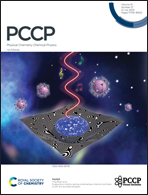Significantly anisotropic Raman response of the (110) surface in quasi-one-dimensional system (TaSe4)2I by polarized Raman spectroscopy†
Abstract
Quasi-one-dimensional materials are usually characterized by optical response spectroscopy methods, which show significant polarization dependence. Herein, we report a systematical investigation of polarized Raman scattering on the (110) crystal surface of the layered (TaSe4)2I compound. Taking into account group theory analysis of the crystal structure and the Raman tensor transformation technique, the vibrational mode of the Raman peaks can be differentiated by the angular dependence of the Raman peak intensity in parallel and vertical polarization Raman scattering tests. Moreover, density functional perturbation theory (DFPT) calculation confirmed the form of the Raman tensor of the (110) crystal surface, which was consistent with the result of the Raman tensor transformation technique, and the Raman spectrum and phonon dispersion curve calculations were also performed based on the Vienna ab initio simulation package (VASP). This new method provides useful insight for accurately identifying the lattice vibration behavior in new 2D layered structures.



 Please wait while we load your content...
Please wait while we load your content...